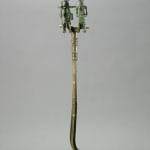Yoruba Bronze Staff, 1800 CE - 1900 CE
Bronze
3.625 x 21.75
PF.5903
Further images
The seated couple gives this staff the appearance of an Edan staff. However, the couple in an Edan pair is traditionally joined by a chain connecting the tops of their...
The seated couple gives this staff the appearance of an Edan staff. However, the couple in an Edan pair is traditionally joined by a chain connecting the tops of their heads. In this example, the male figure wraps his arm around the shoulders of the female. Otherwise, the form and appearance of the figures is typical of Yoruba art. The facial features of the pair, especially their bulging lenticular eyes and pursed lips, are definitively characteristic of the Yoruba style. The couple depicted on this staff no doubt represent a royal pair, apparent from the staff the man holds and the woman’s elaborately braided coiffure. As the staff identifies this man as royalty or a tribal ruler, so this staff would have marked its original owner. Staffs have long been a sign of leadership; just think of the baton de commandment. While the mere presence of this staff signifies rulership, the beauty and masterful craftsmanship of the work enhance its prominence and power. Little attention is dedicated to the other decorative elements of the staff that is reduced to minimal banding along the top, middle, and the curved bottom. Clearly the emphasis is placed upon the verticality of the staff as well as the pair of figures. We can assume that this staff was once proudly held aloft by a king who would have probably appeared much like the male figure crowning the top. Like a jeweled crown, this staff is a mark of royalty. When we feel the weight of the bronze in our hands and hold the staff, a sense of supremacy permeates our souls. Today, we feel the power of possessing a beautiful work of art. However, a deeper, subtler sensation is also experienced: the sensation of holding the same object that an ancient ruler once utilized to maintain the continuity of their authority over the masses. In our hands, this bronze staff makes us feel that we are the king.





